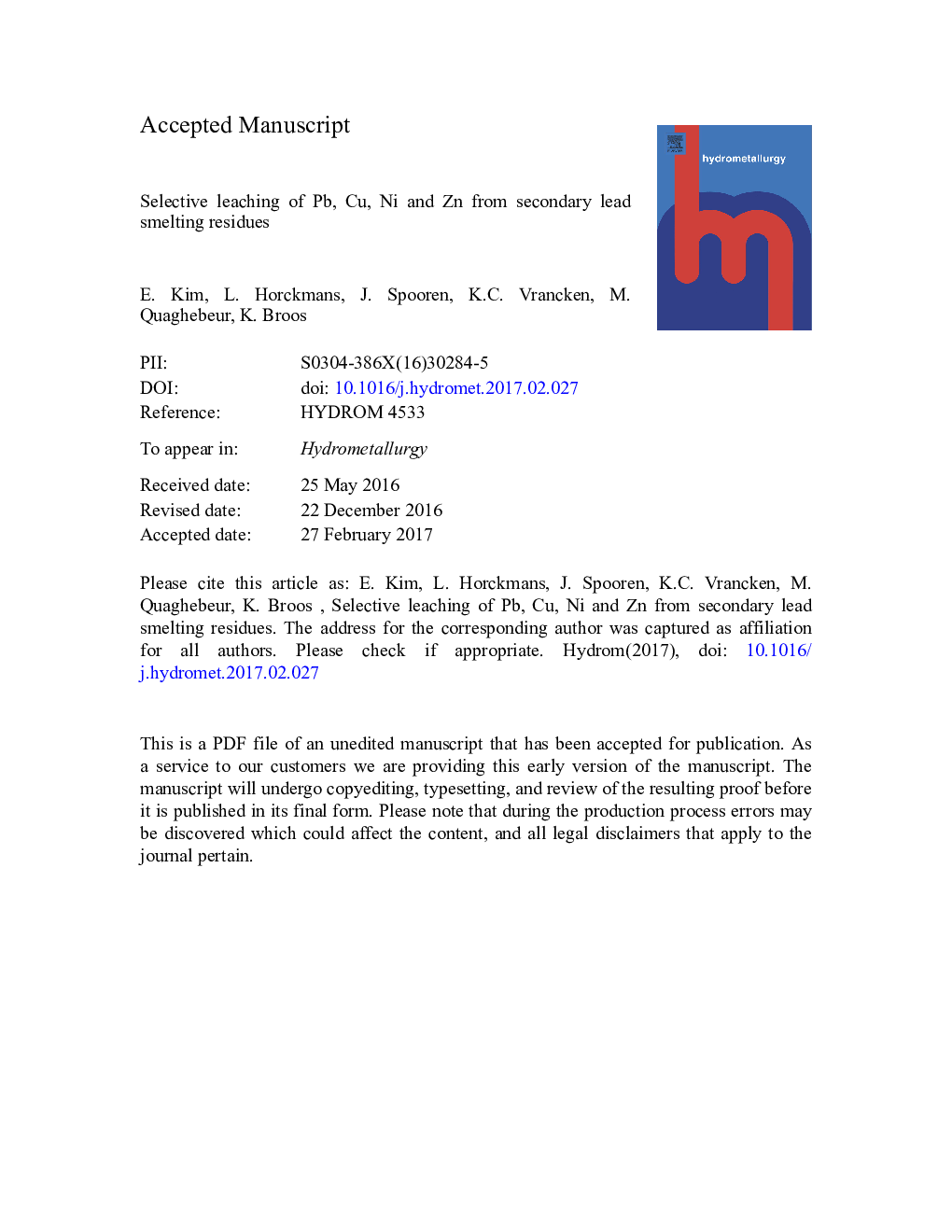| کد مقاله | کد نشریه | سال انتشار | مقاله انگلیسی | نسخه تمام متن |
|---|---|---|---|---|
| 4769348 | 1425535 | 2017 | 37 صفحه PDF | دانلود رایگان |
عنوان انگلیسی مقاله ISI
Selective leaching of Pb, Cu, Ni and Zn from secondary lead smelting residues
دانلود مقاله + سفارش ترجمه
دانلود مقاله ISI انگلیسی
رایگان برای ایرانیان
موضوعات مرتبط
مهندسی و علوم پایه
مهندسی شیمی
مهندسی شیمی (عمومی)
پیش نمایش صفحه اول مقاله

چکیده انگلیسی
Several HNO3-based leaching approaches were tested and optimized to selectively recover Pb and other minor metals (Cu, Ni, Zn) from secondary lead smelter residues (i.e., slag and matte). Firstly, the leaching behaviors of Pb and the matrix element Fe were studied at atmospheric pressure in the temperature range 25-70 °C. These elements were present in both materials studied as sulfide and oxide phases. For the sulfur-rich matte residue, the Pb leaching increased from 63% to 69% upon increasing the HNO3 concentration from 0.2 M to 0.5 M. However, by adding Fe(III) as an oxidation agent, Pb leaching from the matte amounted to 90% at 25 °C. At a higher temperature, Pb leaching was reduced due to PbSO4 precipitation. In this process, Cu, Zn and Ni leaching was insignificant. For the slag residue, HNO3 could not leach Pb (0.03% Pb leached), while Fe leaching was 19.8% due to a galvanic effect. However, Pb leaching of the slag was 82% in the presence of additional Fe(III). Secondly, to enhance leaching of the other base metals (Cu, Zn and Ni) from the matte, roasting followed by water leaching and (microwave assisted or autoclave) pressurized leaching in 0.5 M HNO3 were applied. During roasting, the FeS phase converted to Fe2O3 above 500 °C, and PbS and Pb phases were transformed into insoluble PbSO4 above 400 °C. Cu, Ni and Zn leaching was drastically enhanced by a roasting step at 600 °C followed by leaching with 0.5 M HNO3 at 50 °C, or by pressurized HNO3 leaching above 130 °C, whereby Pb leaching almost ceased due to PbSO4 precipitation. During the roasting above 600 °C, or microwave assisted extraction (MAE) at 160 °C for 15 min, FeS was completely converted to iron oxides that can be used as raw material for pig iron production. Based on the results, the methods investigated can be combined as process steps of two possible routes for the selective recovery of valuable metals and the production of a clean source of Fe oxides from the secondary lead smelting residues studied.
ناشر
Database: Elsevier - ScienceDirect (ساینس دایرکت)
Journal: Hydrometallurgy - Volume 169, May 2017, Pages 372-381
Journal: Hydrometallurgy - Volume 169, May 2017, Pages 372-381
نویسندگان
E. Kim, L. Horckmans, J. Spooren, K.C. Vrancken, M. Quaghebeur, K. Broos,